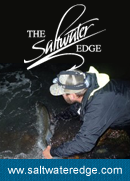The Straight Dope on Striped Bass
This post by Capt John McMurray originally appeared on www.reel-time.com on August 8th
Forget about slot limits and gamefish… address fishing mortality!

Capt. John McMurray
Having served on the ASMFC Striped Bass Advisory Panel for 6 years (not to mention having pretty much built a business on striped bass) I read Lou Tabory’s recent Striper Report 2013 piece in Fly Fishing in Saltwaters Magazine with interest. I have great respect for Tabory. He was a pioneer. His piece provides an interesting historical, albeit anecdotal, perspective on striped bass from the point of view of someone that has fished for them hard over the course of three decades. Yet, I’d have to say that it reflects a general misunderstand most anglers have on the issue.
I’m guessing very few readers of this column would disagree that stripers appear to be headed for trouble. Sure there are still fish around. In fact I’ve had some epic days in the last few years. I’ve seen more 40’s and 50’s in the space of a few days than I’ve seen in my entire life. But it generally lasts no more than a few days as bodies of large fish move through. Gone are the days of consistent schoolie action, with the occasional large fish, which I built a business on. The new pattern seems to be that I’m on them for a few days, then there’s a precipitous lack of fish, sometimes for long stretches. Years ago, getting skunked was rare for me. I can’t say that’s the case anymore. I’m certainly not alone in such observations.
When you look at the recent science this sort of thing makes sense really. Each year, young-of-the year seine surveys are taken in various spots in the Chesapeake Bay. Given the bulk of the striped bass resource is produced in the Chesapeake watershed it’s a pretty good indicator of what we can expect to see in the fishery moving forward. During the last 8 years such surveys have shown average to well-below average young-of-the-year numbers, with the anomalous exception of 2011 which was quite good. This trend is much different from the prior decade where we had several banner year classes. All of this coincides with what guys like me are seeing on the water. Good, albeit very limited runs of larger older striped bass – those fish that are generally older than 9 or 10 years. As these fish grow older we continue to hammer on them while they become larger, yet few and fewer, and there isn’t much behind them.
Why are we having these poor young-of-the-year indices? There is some pretty good science out there suggesting it’s climate-related. NOAA scientists have documented what they’re calling an “Atlantic Multidecadal Oscillation” (AMO), a combination of wind and ocean currents in the North Atlantic that seems to change every 35 years or so. When such a shift happens, it affects local weather along the Atlantic Coast, providing deliberate temperature and precipitation shifts, and subsequently river flow and salinity changes. During a warm phase springtime along the East Coast tends to be wet and cool — more rain, more water, and more food for just-hatched stripers. And during such trends we’ve had good young of the year indices, and subsequently striper numbers go up. Then, 35 years or so later the AMO flips and we have drier springs, less rain, less food. After a lag, striper numbers start to decline. This appears to be where we’re at right now. And guess what… A prior AMO flip coincided with the poor young-of-the-year indices that contributed to the striper crash in the 1980s. When that cycle ended, stripers recovered, not just because of the moratorium, but likely because conditions for their success became more favorable.
So yes, there are likely natural factors at work here, which managers of course have no control over. But… they do have control over fishing mortality, and regardless of the cause, given the decline both anecdotally and on paper, they should be reducing mortality! Just about everyone and their mothers are asking them to do something! But they aren’t… Because technically, striped bass are not overfished, and overfishing isn’t occurring.
Striped bass are managed by fishing mortality and spawning stock biomass thresholds for management action. These are parameters that ASMFC scientists have put on the stock, that if exceeded, trigger corrective action such as reducing fishing mortality. Thus far, fishing mortality has remained below the threshold and spawning stock biomass above it. ASMFC is generally not compelled to take action until such thresholds have been crossed. It is, in fact, very rare the ASMFC would take management action unless the science indicated it was necessary. In this case it hasn’t.

Photo by Capt. John McMurray
While certainly Commissioners hear from their constituents, it’s difficult for a lot of them to comprehend there’s a real problem with striped bass conservation when a.) A number of the fish they manage are technically overfished, and/or overfishing is occurring (e.g. winter flounder, weakfish, tautog etc.), b.) There are still pockets of very good striped bass fishing even as the stock contracts, and c.) Most Commissioners simply don’t spend the time on the water that we do. Believe it or not, there are still those managers who frequently say stupid things like “striped bass are eating everything” when discussing species they have failed to properly manage like winter flounder, or river herring. Such assertions are ridiculous give the historical abundance of such species side-by-side in the same environment.
But I’m getting into too much detail here. Given the abundant evidence of a decline and the importance of the striped bass stock to the recreational fishing industry, a good case for precautionary action can certainly have been made. Unfortunately, despite the clear fact that the majority of stakeholders wanted to see a reduction in fishing mortality, ASMFC punted with Addendum 3 (their 2011 chance to reduce fishing mortality), and we’ll now have to wait for the results of the 2012 benchmark, which is being peer-reviewed right now, and 2014 (if we’re lucky) for new regulations, assuming ASMFC wises up and opts to reduce fishing mortality.
And simply reducing fishing mortality is all we need ASMFC to do! Yet the point of this blog is that the fishing public (even well respected guys like Tabory) seem to keep talking about things like slot-limits (a fish in-between a certain size limit) and game fish status (making the species recreational only) as if these two things are the antidote to the striped bass decline. They aren’t!
A striped bass coastal slot limit, unless it’s crafted in a way that distributes mortality (which is actually very hard to do), is unwise. For one, such slot limits tend to place a lot of pressure on very specific year classes. By implementing a slot limit we’d run the risk of severely depleting a weak year class that happens to fall within a slot limit’s bounds. Given the average to well-below-average young-of-the-year indices during the last 8 years (with the exception of 2011) one can see how a coastal slot limit may be problematic in the striped bass fishery.
Because smaller fish (e.g. 24 to 28”) are generally easier for the fishing public to catch, fishing mortality would go through the roof. In other words, a lot more fish are killed with such a slot than if the size limit had remained at 28” (or in a perfect world 36”), and a lot more are killed before they have had a chance to spawn! Allowing a fish to spawn at least once before it’s killed is fisheries management 101, and that’s essentially what a 28” size-limit seeks to do. With a species like striped bass, the key to effective management is allowing enough older, larger and more fecund fish, representing a number of age classes, to survive, in order to assure that there is adequate spawning stock in reserve to make up for the poor or missing year classes. That is best done by reducing mortality, not by imposing a slot limit.
 The answer to the striped bass problem isn’t a slot limit, it’s actually much simpler. Managers just need to reduce fishing mortality. Whether that’s done with a higher size limit, smaller bag limit, or a shorter seasons is irrelevant. But you generally can’t reduce fishing mortality using slot limits.
The answer to the striped bass problem isn’t a slot limit, it’s actually much simpler. Managers just need to reduce fishing mortality. Whether that’s done with a higher size limit, smaller bag limit, or a shorter seasons is irrelevant. But you generally can’t reduce fishing mortality using slot limits.
Now let’s talk about the popular “gamefish” fix, which a lot of people mistakenly think is the magic bullet. Yes it’s easy to point the finger at commercial fishermen. I’m the first one to admit that it’s incredibly irritating when the boat next to you is bailing fish he intends to sell, either legally or illegally. But assuming the problem is fishing mortality anglers are definitely the largest perpetrators. The commercial fishery is controlled through quotas, so commercial fishermen cannot go over the “harvest cap” set by the state (at least not legally). The recreational fishery, on the other hand, is managed through bag and size limits. The growing popularity of fishing for stripers and the lack of any sort of recreational harvest cap has allowed a large increase in recreational mortality over the years while commercial mortality has remained virtually static. In 2006, the year the recreational striper fishery peaked, recreational dead discards alone (those fish that didn’t survive the release) were around double the total commercial catch. Pretty startling right?
I’m not saying commercial fishermen are not part of the problem. They certainly are. It was hard to miss all the photos and videos of acres of dead discards from North Carolina trawlers a couple of years ago. Equally disturbing were the tens of thousands of pounds of dead stripers caught in illegal gill-nets found in Chesapeake tributaries. This is likely just the tip of the iceberg when it comes to discards and poaching. But let’s be honest. Such dead fish, while an inexcusable waste of the resource, still pale in comparison to recreational mortality. Couple this with the fact that some coastal states who were able to get gamefish status after the last crash ended up giving their commercial quota to anglers, and it’s hard to argue for game-fish with a straight face. Until we get recreational mortality under control, “wealthy anglers taking fish away from hard-working commercial fishermen” doesn’t play well with decision-makers. “Gamefish” is empowering, and of course I support the theory, but these are the realities of the situation.
 Assuming striped bass continue to decline, there is a rationale for gamefish, but thus far the angling community hasn’t picked up on it. I don’t really have the space to fully explain this here but will certainly do so in a future blog (perhaps the next one if nothing pressing comes up). Regardless, the reality is that gamefish is politically very difficult right now, and in my mind a nonstarter.
Assuming striped bass continue to decline, there is a rationale for gamefish, but thus far the angling community hasn’t picked up on it. I don’t really have the space to fully explain this here but will certainly do so in a future blog (perhaps the next one if nothing pressing comes up). Regardless, the reality is that gamefish is politically very difficult right now, and in my mind a nonstarter.
If the recreational fishing community continues to perpetuate the myth that it’s commercial fishing that’s causing the decline or, that a slot limit is the answer, it will just strengthen the idea that many, if not most, Commissioners harbor– that the recreational community doesn’t really get it. And so, they can just disregard us. I’ve had personal conversations with such Commissioners who have told me, in so many words, that this is the case. This is essentially what’s been happening over the last several years as Commissioners fail to listen to constituent pleas for precautionary management action.
We need be clear on what we, as a community of stakeholders, want. A reduction in fishing mortality. So that we can enjoy the abundance of fish we had just five years ago and so recreational fishing business can continue to thrive and so that anglers can continue to enjoy a rebuilt, abundant fishery. I don’t see any reason for a two-fish coastal limit. And really, the size limit should probably be higher. But how it gets done doesn’t really matter to me, and it shouldn’t to you. Reduce fishing mortality! That’s what our message should be!
At this point, whether ASMFC does reduce fishing mortality is really contingent on what the 2012 benchmark stock assessment reveals, and of course how much noise those of us who fish for this amazing animal (and those of who depend on this fishery make a living) make.
The 2012 assessment is currently being peer-reviewed, yet I suspect it will be released very soon. I will let readers know what it says just as soon as we have it. Stay tuned!
After obtaining an undergraduate degree in Political Science from Loyola College in Maryland, Captain John McMurray served in the US Coast Guard for four years as a small-boat coxswain and marine-fisheries law enforcement officer. He was then recruited to become the first Executive Director of the Coastal Conservation Association New York. He is currently the Director of Grants Programs at the Norcross Wildlife Foundation in New York. He is the owner and primary operator of “One More Cast” Charters. John is a well known and well published outdoor writer, specializing in fisheries conservation issues. In 2006 John was awarded the Coastal Conservation Association New York Friend of Fisheries Conservation Award.












It all sounds solid to me.
↓Striped bass larger than 28″ are ready to reproduce and have developed survival skills. Therefore, I support the keeping of a striped bass through a tag program. Each participating fisherman can keep any size bass if they still have a tag remaining from an amount issued at the beginning of each season; I would suggest 3-4 tags per fisherman. The tags should be non-transferable and once used, no additional tags would become available. The tags must be filled in to assure that no tag is reused. This system tied to greater enforcement is a sensible way to proceed and would help to increase the number of striped bass.
↓Thanks for the article, big wakeup for me regarding a slot limit which I thought was a good idea, lets get back to a 28″ or even higher one fish per day limit.
↓Thanks again
“The commercial fishery is controlled through quotas, so commercial fishermen cannot go over the “harvest cap” set by the state (at least not legally).” Anybody who believes this drivel would have to deny what can be seen with ones eyes up and down the Atlantic coast. “At least not legally”? That’s exactly the point!!!
“If the recreational fishing community continues to perpetuate the myth that it’s commercial fishing that’s causing the decline or, that a slot limit is the answer, it will just strengthen the idea that many, if not most, Commissioners harbor– that the recreational community doesn’t really get it. And so, they can just disregard us. ” For openers it’s no myth and as for the Commissioners disregard of the recreational community, that is due to them wanting to keep on being Commissioners. They know full well they will lose their appointment the moment they decide against a system that favors the status quo for the commercial side.
We may not have the political clout to achieve any meaningful change but stop asking us to buy into this BS.
Marc
↓Absolutely Brilliant! John, great job explaining and Z, great job posting this. John, what should we do? Is there a recommended organization, something we should say to our representative, etc.? We (SJ Readers) are a great resource and we could help. I look forward to being involved.
↓C’mon, we all heard the Man, *** 1 *** fish @ 36″ for 5 years….. give the striper stock some breathing room …..surf, charter, party boat….. *** 1 *** @ 36″ ….. let’s try it, if only for US A-N-D the fish we chase ?? What do you think ?
↓Forget size limits for a moment. If reducing mortality is key, we need to stop killing so many big fish. We also should start to let them back to the water properly, and not toss them of rocks into the surf . I still like to keep a fish now and then, but if you keep showing video that start with Bass gasping on the beach, slews of anglers walking from the beach dragging bass , tossing them from rocks you are sending the wrong message. Reducing mortality should be on every ones shoulders.
↓Why not cut the recreational limit and commercial quota in half. Start there
↓You say that a slot limit is not the answer and I see your point you will hurt that year class but now it is 28 and over (that is the slot). Why not put all the big breeders back. Take a photo of the trophy and put it back. Don’t the big females produce ten times the eggs and aren’t 90% of the forty plus females.
Look at the lobster industry they put the egg producers and extra large ones back.
This was a very well written and logically sound article. It effectively changed some of the perceptions that I personally had regarding the state of the striped bass fishery and how to manage it. I think we all have an idea about what is the best way to reduce the mortality, but the message from us should be “we support mortality reduction – in any form”. That is a simple loud and clear message that the recreational sector can send, and it should be the truth. That’s a message that I will be hailing and anecdotal to that will be what I think is the best way. I would venture that 90% of us, while having good intentioned ideas, do not know enough about fisheries management to give a solid opinion on “how”. Let’s have a common voice on “what”.
↓I’m confused, you wrote
↓“A prior AMO flip coincided with the poor young-of-the-year indices that contributed to the striper crash in the 1980s. When that cycle ended, stripers recovered, not just because of the moratorium, but likely because conditions for their success became more favorable.”
If the AMO plays a larger role than even a full bown moratorium, how will reducing the mere reduction of fishing mortality stem the tide?
Thanks that was quite eye opening. Ya i’ve been in favor of a 36 or 38 min and one fish. Still have to teach a lot of folks how to properly handle and release an undersized fish.
↓